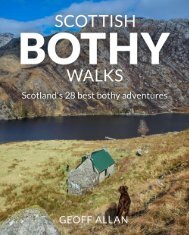Scottish Bothy Walks - 28 best bothy adventures
Scottish Bothy Walks describes 28 sensational walking adventures, visiting Scotland’s finest bothies. Choosing his favourite bothies as the focal point, Geoff Allan guides the reader on a mix of day walks and multi-day excursions, highlighting the incredible mountains, wildlife, geography and history that you will find along the way. Combining beautiful photos, detailed route descriptions, points of interest and downloadable instructions, this is the ultimate companion for bothy-lovers and those exploring Scotland’s wilds, written by Scotland’s premier bothy expert.
Scottish Bothy Walks describes 28 sensational walking adventures, visiting Scotland’s finest bothies. Choosing his favourite bothies as the focal point, Geoff Allan guides the reader on a mix of day walks and multi-day excursions, highlighting the incredible mountains, wildlife, geography and history that you will find along the way. Combining beautiful photos, detailed route descriptions, points of interest and downloadable instructions, this is the ultimate companion for bothy-lovers and those exploring Scotland’s wilds, written by Scotland’s premier bothy expert.
- No tags were found...
You also want an ePaper? Increase the reach of your titles
YUMPU automatically turns print PDFs into web optimized ePapers that Google loves.
BOTHIES & BOTHYING<br />
‘A simple shelter in remote<br />
country for the use and benefit<br />
of all who love being in wild and<br />
lonely places’.<br />
Definition from the MBA members’ handbook<br />
Scotland’s bothies are a loose collection of<br />
shepherds’ cottages, estate houses and<br />
abandoned crofts that have been saved<br />
from ruin and renovated. They form a network of<br />
basic shelters located throughout the country’s<br />
most remote and uninhabited regions. Freely<br />
available for anyone to use as a lunch stop, or<br />
to stay in overnight, bothies have been used by<br />
mountaineers and stravaigers for well over a<br />
hundred years and become integral to Scotland’s<br />
outdoor culture.<br />
In very simple terms, there are many derelict<br />
properties scattered across the <strong>Scottish</strong><br />
landscape because of the waves of depopulation<br />
that began in the mid- to late-18th century and<br />
did not ease until after World War II. The initial<br />
driving force behind the exodus was a process<br />
of forced evictions known as the ‘Highland<br />
Clearances’. People then continued to abandon<br />
their communities when harvest failures led to<br />
illness and famine, with many leaving for the<br />
industrial heartland that grew rapidly in Lowland<br />
Scotland through the Victorian era.<br />
The term <strong>bothy</strong> derives from the Gaelic bothan<br />
(via the Old Irish both) meaning hut, and originally<br />
described rough-and-ready accommodation<br />
provided by landowners for farm labourers or<br />
estate workers. More recently the term has<br />
become synonymous with an idea of sanctuary<br />
and shelter. This cultural transition began in the<br />
1930s, with the rise in popularity of hillwalking<br />
among the urban populations of Glasgow,<br />
Edinburgh and Aberdeen. Short of money, but<br />
with more leisure time on their hands, groups<br />
of mainly young men used these partly derelict<br />
cottages as places to congregate and sleep for<br />
free during hard-earned weekends. In some cases<br />
this practice was clandestine, but increasingly,<br />
various estates gave their tacit consent.<br />
The rural exodus following World War II left an<br />
increasing number of farmhouses unoccupied,<br />
and walkers simply started using them as<br />
somewhere to stay overnight. By the 1960s,<br />
however, the fabric of many of these properties<br />
began to suffer through misuse and lack of<br />
maintenance. A few were cared for by climbing<br />
clubs, but the remainder received little attention.<br />
I strongly believe the <strong>bothy</strong> tradition in its<br />
current form would not have endured without<br />
the invention of the MBA, which came into<br />
existence in 1965. Bernard Heath, a keen cyclist<br />
and hillwalker was inspired by a chance remark<br />
in a <strong>bothy</strong> book suggesting the establishment<br />
of a club to keep bothies in good repair. He and<br />
a few of his friends decided to restore the ruins<br />
of Tunskeen Farm in Galloway, and the following<br />
November a group of like-minded individuals<br />
gathered in nearby Dalmellington village hall<br />
where the Mountain Bothies Association was<br />
born. During the next five decades the MBA<br />
extended its renovation work across the country,<br />
as well as taking over the upkeep of many bothies<br />
maintained by various climbing clubs. Today<br />
there are over 80 MBA bothies in Scotland as<br />
START BAY, FROM START 13 POINT



